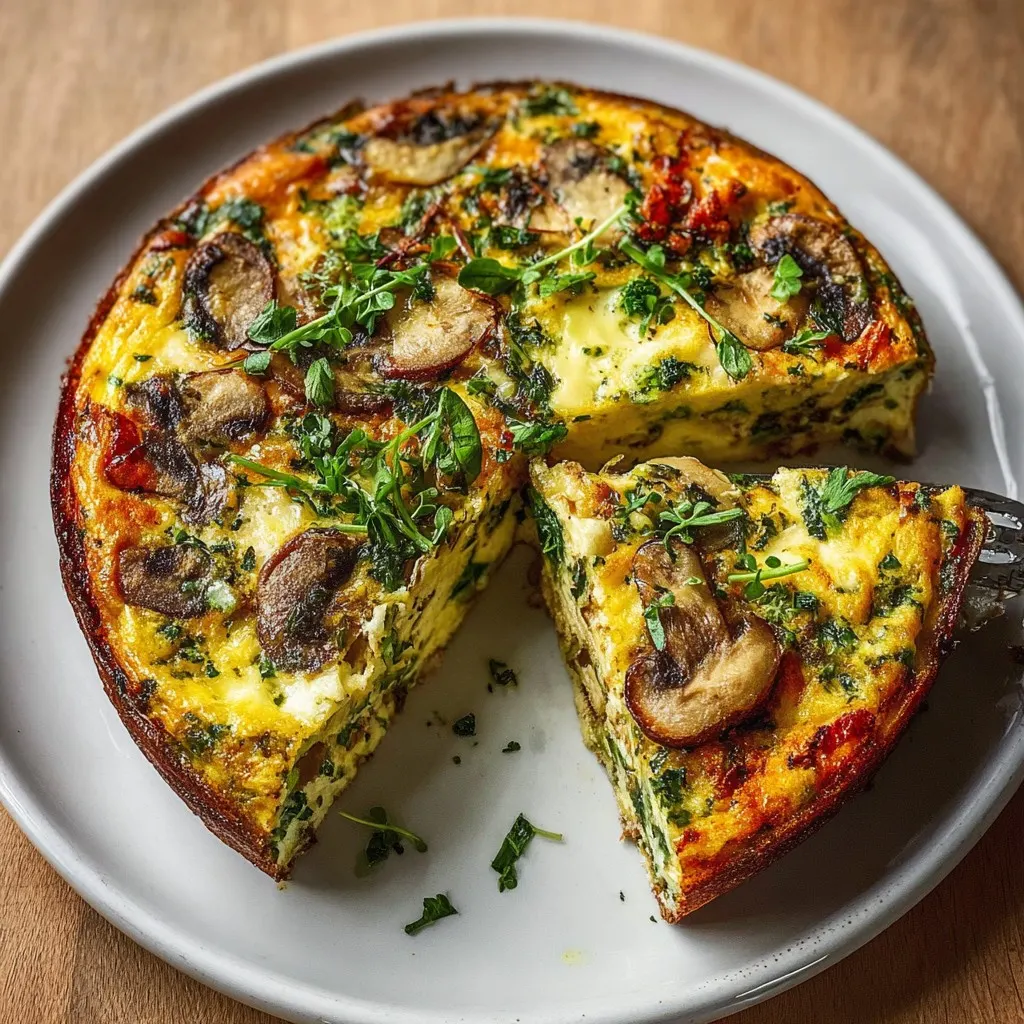Let Me Tell You About This Frittata (And My Awkward First Attempt...)
Oh, the first time I made a frittata was a complete fiasco. I thought I could just wing it (as usual!), but let’s just say burnt eggs and a slightly smoking oven aren’t my proudest kitchen memories. Still, I learned. These days, whipping up “The Best Frittata Recipe” is my party trick. My friends think I’m some kind of brunch wizard, but really—it’s just easier than pretending to like overnight oats. Anyway, if you ever come over on a Sunday, odds are you’ll get a slice of this, some shaky coffee, and probably a bit of unsolicited life advice.
Why I Keep Making This (And My Family Thinks I’m a Genius)
I make this when I’ve got too many random leftovers in the fridge. My family goes crazy for it because it’s hearty, cheesy, and you can honestly put anything in it (except pineapple—my youngest tried that once, nope). Plus, it comes together so fast, I don’t even have time to mess it up. Okay, usually. If you hate washing up—same, mate—it all happens in one pan, so I’d say that’s a win. It’s the thing I lean on when I forgot to defrost anything else or when there are a few grumpy faces demanding breakfast-now-please.
What You’ll Need For This Frittata (Substitutes? Oh Yes!)
- 6 large eggs (sometimes I use 7 if they’re those dinky ones from the farm down the road)
- ⅓ cup milk (whole is best, but honestly, 2% works in a pinch, oat milk was acceptable on that weird vegan week)
- 1 cup grated cheese (cheddar is classic; feta if I’m feeling fancy or just ran out of cheddar—parmesan, why not?)
- 1 handful sautéed veggies (think spinach, peppers, onions...or whatever’s suspiciously wilting in the fridge)
- 4 slices cooked bacon or ham (leftover sausage also works, my aunt once used smoked tofu and it was...interesting)
- 2 tablespoons chopped fresh herbs (parsley, dill, or absolutely nothing, if your windowsill plants are as dead as mine)
- Salt & pepper (grandma used to use that fancy flaked stuff, I just grab whatever’s closest)
- 1-2 tablespoons olive oil (or butter—but, confession time, I like the buttery taste more)
How To Make It—Don’t Overthink, Just Cook
- Preheat your oven broiler (high) if your pan can go in the oven. Actually, I sometimes forget this step until I’ve already started—no biggie, but it helps.
- Crack the eggs into a bowl and whisk with milk, salt, and pepper. Don’t freak out about overbeating; just whisk until it’s not streaky. Sometimes I use a fork if the whisk is hiding.
- Heat olive oil or butter in a medium oven-safe skillet (mine’s 9 inches, but bigger means thinner frittata, which is fine too). Toss in your veggies & bacon, cook until everything’s hot and smells amazing. This is where I usually sneak a taste.
- Pour in the eggs, sprinkle over the cheese & herbs. Give the pan a little shake. Don’t stir too much once it’s in the pan; just gently nudge the edges if they set up faster. If it looks a bit weird at the edge—don’t worry, it sorts itself out.
- Let it cook on medium-low for about 5 minutes. You want the edges set but the middle a bit jiggly. (That word is for you, cousin Mike, who hates it, sorry.)
- Pop the pan under the broiler for 2-3 minutes until the top is puffy and golden. Keep an eye out—it goes from perfect to overdone faster than you’d think. (I burned the top once replying to a group chat. Oops!)
- Take it out, let cool for a couple mins. In theory, you’re supposed to serve it in neat wedges, but I’ve been known to hack at it straight in the pan. No shame.
Notes, As Learned The Hard Way
- If you skip pre-cooking the veggies, they’ll leak water. It’s not terrible, just a bit soggy. Actually, I find it works better if you let them get a bit caramelized.
- Too much cheese will make it greasy—but, honestly, that’s not always a bad thing is it?
- Try not to use a pan with a plastic handle unless you enjoy the smell of melting plastic. Ask me how I know.
Stuff I’ve Tried (And Not All of It Worked)
- Added cooked potatoes—so filling, great if someone skipped breakfast. Even tried leftover hash browns, not half bad.
- Tried a "Greek" version with olives and feta: really fun. Pineapple experiment—never again. Trust me.
- Made mini frittatas in muffin tins—cute, but a pain to get them out unless you grease well (so, do that).
Don’t Have a Skillet? No Drama
If all you’ve got is a baking dish, just mix everything and bake at 375°F (190°C) for 20–25 min. It’s a bit more like a crustless quiche, but still brill. Or I’ve even done this in a deep pie plate once when I couldn’t find the skillet (you’d be amazed at my kitchen’s ability to hide things).

Keeping Leftovers (But Seriously, Good Luck)
Wrap slices up and store in the fridge up to 3 days, but honestly, in my house it never lasts more than a day! It’s surprisingly good cold, or reheat briefly in the microwave.
Oh, And How I Serve Mine
My favorite way: warm, with a pile of peppery arugula and a slice of crusty bread. My kids pile on ketchup (yikes, but whatever—they eat it). If you want it as more than a breakfast, throw some roasted potatoes on the side, or little tomatoes, or just eat it straight from the pan. We once had it with leftover salsa and that was actually ace.
Pro Tips From Someone Who’s Messed It Up
- Don’t rush the stovetop bit; I once tried high heat to speed things up—ended up with rubbery eggs, bleh.
- If you’re doubling the recipe, use a bigger pan. I forgot once and had egg lava overflow; still tasted okay, but cleanup was brutal.
- If your cheese is clumped, sprinkle as you pour in the eggs, not after. Learned that off Serious Eats—great resource, btw.
Questions I Actually Get Asked (And My Non-Expert Answers)
- Can I make it dairy free? Yep! Use any neutral-tasting non-dairy milk; skip the cheese or use one of those decent vegan ones. Cashew cheese melts ok, actually.
- How do I keep it from sticking? Butter and a good pan are your friends. Or, line the pan with parchment if you dare—sometimes it works, sometimes, not so much.
- Can I freeze it? I wouldn’t—it’s edible, but the texture gets a bit odd. (On second thought, if you’re desperate, freeze individual pieces, then reheat in the oven at 350°F. But fresh is way tastier.)
- What veggies are best? Almost any! Spinach, bell peppers, onions, mushrooms. Avoid tomatoes unless you cook or drain them—too much water, way too much hassle.
- Is it healthy? Well, it’s got protein, veggies, not much flour—it’s pretty good. Well, depending on how much cheese you add.
If you want more frittata inspiration, check out Smitten Kitchen’s version—she does great things with broccoli. Always nice to see new twists, right?
Oh! Before I forget: don’t panic if your first frittata isn’t Instagram-pretty. Mine never are, but they’re always eaten. And that’s what counts, innit?
Ingredients
- 8 large eggs
- ½ cup whole milk
- 1 cup spinach, fresh and chopped
- ½ cup cherry tomatoes, halved
- ½ cup shredded mozzarella cheese
- ¼ cup grated parmesan cheese
- 1 small onion, finely diced
- 2 tablespoons olive oil
- ¼ teaspoon salt
- ¼ teaspoon black pepper
Instructions
-
1Preheat your oven to 375°F (190°C).
-
2In a large bowl, whisk together the eggs, milk, salt, and black pepper until well combined.
-
3Heat olive oil in an oven-safe skillet over medium heat. Add the diced onion and sauté for 3-4 minutes until tender.
-
4Add the spinach and cherry tomatoes to the skillet and cook for another 2-3 minutes, until the spinach is wilted.
-
5Pour the egg mixture into the skillet and let cook undisturbed for 2-3 minutes. Sprinkle mozzarella and parmesan cheese evenly over the top.
-
6Transfer the skillet to the oven and bake for 15-18 minutes, or until the frittata is set and slightly golden. Let cool for a few minutes before slicing and serving.
Approximate Information for One Serving
Nutrition Disclaimers
Number of total servings shown is approximate. Actual number of servings will depend on your preferred portion sizes.
Nutritional values shown are general guidelines and reflect information for 1 serving using the ingredients listed, not including any optional ingredients. Actual macros may vary slightly depending on specific brands and types of ingredients used.
To determine the weight of one serving, prepare the recipe as instructed. Weigh the finished recipe, then divide the weight of the finished recipe (not including the weight of the container the food is in) by the desired number of servings. Result will be the weight of one serving.
Did you make this recipe?
Please consider Pinning it!!


